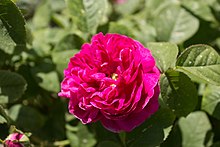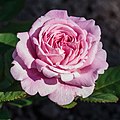
Rosa canina, the dog rose, is a variable climbing, wild rose species native to Europe, northwest Africa, and western Asia.

Rosa 'Ispahan', also known as 'Rose d'Ispahan' and 'Pompon des Princes', is a clear pink, half-open kind of Damask rose, a type of garden rose introduced from the Middle East to Europe during the crusading 13th century.

Rosa gallica, the Gallic rose, French rose, or rose of Provins, is a species of flowering plant in the rose family, native to southern and central Europe eastwards to Turkey and the Caucasus. Rosa gallica was one of the first species of rose to be cultivated in central Europe. It is a parent of several important cultivars.

The cottage garden is a distinct style that uses informal design, traditional materials, dense plantings, and a mixture of ornamental and edible plants. English in origin, it depends on grace and charm rather than grandeur and formal structure. Homely and functional gardens connected to cottages go back centuries, but their stylized reinvention occurred in 1870s England as a reaction to the more structured, rigorously maintained estate gardens with their formal designs and mass plantings of greenhouse annuals.

Rosa × damascena, more commonly known as the Damask rose, or sometimes as the Iranian Rose, Bulgarian rose, Taif rose & "Emirati rose", Ispahan rose, Castile rose, and Đulbešećerka is a rose hybrid, derived from Rosa gallica and Rosa moschata. DNA analysis has shown that a third species, Rosa fedtschenkoana, has made some genetic contributions to the Damask rose.

Rosa 'La France' is a pink rose cultivar found in France in 1867 by the rosarian Jean-Baptiste André Guillot (1827–1893). It is generally accepted to be the first hybrid tea rose. Its introduction is therefore also considered the birth of the modern rose. As the cultivar was not systematically bred, its hybrid parentage can only be speculated, but 'Madame Falcot' is considered as a possible parent.

Rosa'Veilchenblau' is a mauve hybrid multiflora rose cultivar and the best known violet rambler. Other names are 'Bleu-Violet', 'Blue Rambler', 'Blue Rosalie' and 'Violet Blue'.

Rosendals Trädgård is a garden open to the public situated on Djurgården, west of Rosendal Palace, in the central part of Stockholm, Sweden. Today, Rosendals Trädgård is open to public visitors in order to let visitors experience nature and to demonstrate different cultural effects on gardening through history. The purpose is to practise biodynamic agriculture and pedagogical education. The garden is owned and operated by the trust fund "Rosendals Trädgårds Stiftelse". In the area known as Rosendals Trädgård there are also, except from the garden: "Plantboden", a gardening shop where the customers can find everything that's useful in a garden, "Trädgårdsbutik", a shop where the customers can buy fresh vegetables cultivated in the garden at Rosendal. The maybe most visited shop is the famous bakery, which carries the same name as the garden, "Rosendal Trädgårds bakery". Visiting Rosendals Trädgård, one has a great opportunity to experience locally cultivated and produced phenomena and items.
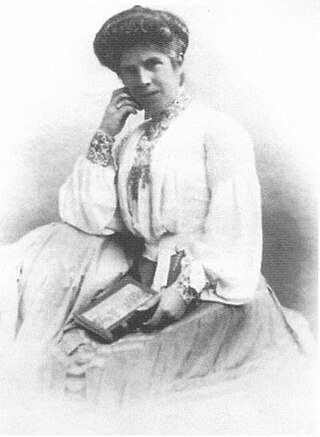
Ellen Ann Willmott was an English horticulturist. She was an influential member of the Royal Horticultural Society, and a recipient of the first Victoria Medal of Honour, awarded to British horticulturists living in the UK by the society, in 1897. Willmott was said to have cultivated more than 100,000 species and cultivars of plants and sponsored expeditions to discover new species. Inherited wealth allowed Willmott to buy large gardens in France and Italy to add to the garden at her home, Warley Place in Essex. More than 60 plants have been named after her or her home, Warley Place.

Rosa 'Old Blush', also known as 'Parsons' Pink China', 'Old Blush China', 'Old China Monthly', is a China rose and has been cultivated in China for over a thousand years. It derives from Rosa chinensis, and is generally accepted as the first East Asian rose cultivar to reach Europe. It is recorded in Sweden in 1752 and in England before 1759, but was probably cultivated in China for several centuries. It is believed to be the rose which inspired the song The Last Rose of Summer by the Irish composer and poet Thomas Moore. It is also known as Parsons' Pink China, named after Mr Parson who introduced it commercially to the UK in 1793.

Garden roses are predominantly hybrid roses that are grown as ornamental plants in private or public gardens. They are one of the most popular and widely cultivated groups of flowering plants, especially in temperate climates. An enormous number of garden cultivars has been produced, especially over the last two centuries, though roses have been known in the garden for millennia beforehand. While most garden roses are grown for their flowers, often in dedicated rose gardens, some are also valued for other reasons, such as having ornamental fruit, providing ground cover, or for hedging.

Rosa 'Nevada' is a white climbing rose cultivar developed by Pedro Dot in Spain in 1927. It is one of his most successful creations and is named for its colour, as nevada is the Spanish word for "snowy". Its parentage was long under discussion, as Dot introduced the cultivar as a hybrid moyesii, but the cultivar's round, black hips point to its R. pimpinellifolia-parentage. It is probably a cross between Dot's pink hybrid tea 'La Giralda' and the wild rose species Rosa pimpinellifolia var. altaica, but is sometimes still described as a hybrid moyesii.
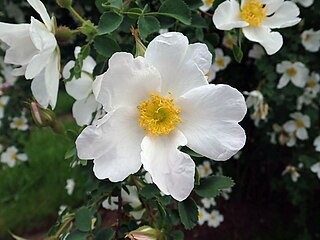
Rosa fedtschenkoana is a species in the plant genus Rosa in the family Rosaceae. Some authorities consider it a synonym of Rosa webbiana. It is native to the foothills of the Ala Tau, Tian Shan and Pamir-Alai mountain ranges in central Asia and northwest China. It is named after Olga Fédchenko, a Russian botanist. It is deciduous, forming a bushy and suckering shrub up to 2.5 metres high and as much across. The branches are covered in many prickles, many of which are fine and straight, but some are thicker and slightly hooked. The pinnate leaves are pale greyish green in colour and have usually between 7 and 9 leaflets. The flowers are white, up to 5 cm across, and are borne singly or in small clusters at the tips of the branches throughout the summer months. The flowers' scent has been described as being "like 'Hovis' [brown] bread with a little blackberry jam". The flowers are followed by small, pear-shaped, bristly orange-red fruits.

Remontancy is the ability of a plant to flower more than once during the course of a growing season or year. It is a term applied most specifically to roses, and roses possessing this ability are called "repeat flowering" or remontant. The term originated in the nineteenth century from the French verb remonter or 'coming up again'. Roses which lack this ability are termed "summer flowering", "once flowering" or non-remontant. Few wild rose species possess remontancy; notable exceptions being Rosa chinensis, Rosa rugosa and Rosa fedtschenkoana.

Rosa 'Arthur Bell',, is a yellow rose cultivar, bred by Sam McGredy IV in Northern Ireland in 1964. The rose has won numerous awards, and is popular in England and Northern Europe.
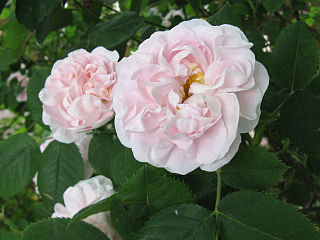
Rosa 'Great Maiden's Blush' is white blend Alba rose cultivar that appeared during the 14th century. It was introduced in Australia by Camden Park in 1843 as 'Maiden's Blush'. 'Great Maiden's Blush' has received the Royal Horticultural Society's Award of Garden Merit, and the American Rose Society's Dowager Queen award at the Syracuse Rose Society show.

Rosa'Buff Beauty' is an apricot Hybrid musk rose cultivar, bred by Ann Bentall and introduced into Great Britain in 1939. Bentall and her husband, John Bentall, inherited the rose fields of acclaimed rose breeder, the Reverend Joseph Pemberton after his death in 1926. The rose was awarded the Royal Horticultural Society's Award of Garden Merit in 1993.

Rosa 'Fragrant Cloud',, is a hybrid tea rose cultivar, bred by Mathias Tantau, Jr. in Germany in 1963. The plant was created from stock parents, Rosa 'Prima Ballerina' and Rosa 'Monteauma'. 'Fragrant Cloud' has won multiple awards, including the Portland Gold Medal in 1966, the James Gamble Fragrance award in 1970, and induction into the Rose Hall of Fame as "World's Favourite Rose" in 1981.

Rosa 'Silver Jubilee' is an apricot blend hybrid tea rose created by Scottish rose breeder, Alec Cocker. The rose was named in honour of the Silver Jubilee of Queen Elizabeth II in 1977. The rose was awarded the Royal National Rose Society's President's International Trophy, the Belfast Gold medal, the Portland Gold Medal and the James Mason Memorial Prize.

Rosa 'Munstead Wood' is a dark red shrub rose cultivar, bred by British rose breeder David C. H. Austin, and introduced into the UK by David Austin Roses Limited (UK) in 2007. The cultivar was named after horticulturalist and garden designer Gertrude Jekyll's home, Munstead Wood, in Surrey, England. The rose was awarded the Award of Garden Merit (AGM) by the British Royal Horticultural Society (RHS) in 2007 and an American Garden Rose Selections (AGRS) Fragrance Award, in 2017.
